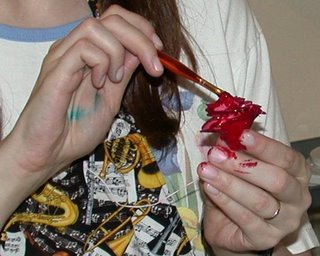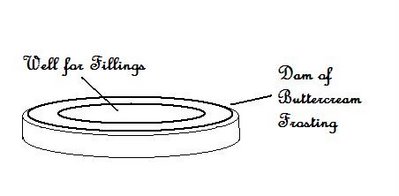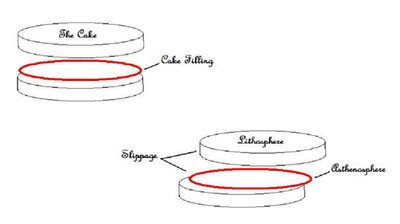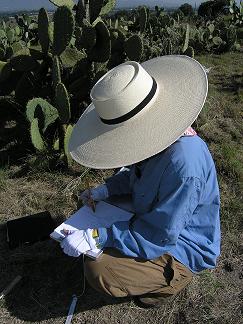Cake Tectonics
Recently, I attempted to make a birthday cake for Mr. Roth, my brother-in-law. He’d been reading a bit about Salvador Dali, so I decided to attempt a cake with a general Dali theme. Due to vagaries of fillings and such, it turned out to be a bit more Dali-esque than I had initially envisioned.
I had imagined making a cake much like the following Dali painting. Admittedly it’s not that exciting. Rose suspended in blue space is a bit like purple unicorns …kitschy and one has a general feeling that it signifies something else. But, frankly, it seemed easier to do in cake form than some of his other more famous paintings. For example, although I do like some of his crucifixions, they’re hardly birthday cake decorating material. At least, not to my mind.

Aside from the decorations, I have standards I wish to uphold in the taste of the cake itself. After ascertaining from Mr. Roth that he wished some sort of chocolate and was also fond of cake and jam, I decided to make him a sour cream fudge cake with chocolate butter frosting (more or less plainly decorated) and some sort of yellow cake with a jam filling.
I picked a golden buttercream cake which has some unique properties. It has a fine crumb and it tastes like it’s going to be a dense pound cake at first and then once it’s in your mouth it melts away. I think it’s something to do with the sugar, or maybe high amounts of butter. And it smells wonderful. It’s from Rose Levy Beranbaum’s Cake Bible (which I highly recommend for her yellow and white butter cakes, I’ve had less success with her chocolate cakes).
Then I had to decide on fillings. I was torn between lemon curd and red raspberry jam. So I optimistically decided to do both. I was going to top it all off with a thin layer of buttercream and then cover that with a quick-pour fondant, which is basically a thick and shiny glaze that I could color in a nice swirly blue with gold glitter to achieve a look at least suggestive of the sky in the painting.
First, I sculpted a red rose using gum paste. Gum paste, for the uneducated, is basically sugar cement that has gum in it making it intially flexible much like clay before drying.
It’s a strange conceit in the world of confectionary, but it appears that aside from fresh and typically edible flowers, all of the sugar decorations are supposed to be technically edible. I say “technically” because they are practically not edible unless you enjoy gnawing hard as rock blocks of sculpted sugar.
Frankly, even the “chewy” gum paste I used to make daisies for a cake wasn’t really all that edible although one enterprising person did actually chomp down quite a few to my amazement. They even ate the royal icing flower pollen centers and inner petals which were made of royal icing, which is made with meringue powder, and is another really hard sugar and not really all that palatable either.
Unfortunately, red tinting in gum paste never turns out as red as I wanted it so I painted it with red paste food coloring for that nice bloody red wet look. For all I know, it’s still wet, the darn thing wouldn’t dry.

I should say that the chocolate cake turned out fine.
It was the fillings in the fancy decorated yellow cake that provide the lesson in cake tectonics.
Cake decorating books will all tell you one thing about using fillings. They advise using an icing dam around the edges of the cake to hold in the filling in the center of the cake so it doesn’t ooze out between cake layers. This illustration gives you the basic idea.

It was my choice of fillings where I made the fatal errors. First, I used lemon curd which already a bit on the gooey and non-stable side. Second, the raspberry jam that I used had seeds, which I hate, so I strained most of them out, thinking I could put the now runny jam into the middle of the lemon curd filling and have it be more or less held into place. That didn’t really work as planned.
The filling had too much liquid and ended up making the top cake layer float atop it not unlike the lithosphere (earth’s crust and the hard part of the mantle) floating atop the more viscous asthenosphere (which wiki says “flows like a liquid in geological time”).

Actually, in real plate tectonics, the pressure from the upper and lower layers produces all kinds of interesting dynamics that obviously don’t apply to cakes. However, the salient point is that the viscosity of the filling made the upper cake layer “unstable” much like the “plates” of earth’s crust.
Witness the happy results in cake form!
It doesn’t look to bad from above, though it is only vaguely reminiscent of the Dali painting.

Here, you can clearly see the movement of the upper layer has put the cake into more of irregular shape with bulging sides and cracks (though you can’t see them) in the fondant covering.

It tasted good and Mr. Roth didn’t appear overly upset at its structural problems.
In future, I will stick to thicker fillings (and less of them) so as not to have any more impromptu lessons in plate motion!
I had imagined making a cake much like the following Dali painting. Admittedly it’s not that exciting. Rose suspended in blue space is a bit like purple unicorns …kitschy and one has a general feeling that it signifies something else. But, frankly, it seemed easier to do in cake form than some of his other more famous paintings. For example, although I do like some of his crucifixions, they’re hardly birthday cake decorating material. At least, not to my mind.

Aside from the decorations, I have standards I wish to uphold in the taste of the cake itself. After ascertaining from Mr. Roth that he wished some sort of chocolate and was also fond of cake and jam, I decided to make him a sour cream fudge cake with chocolate butter frosting (more or less plainly decorated) and some sort of yellow cake with a jam filling.
I picked a golden buttercream cake which has some unique properties. It has a fine crumb and it tastes like it’s going to be a dense pound cake at first and then once it’s in your mouth it melts away. I think it’s something to do with the sugar, or maybe high amounts of butter. And it smells wonderful. It’s from Rose Levy Beranbaum’s Cake Bible (which I highly recommend for her yellow and white butter cakes, I’ve had less success with her chocolate cakes).
Then I had to decide on fillings. I was torn between lemon curd and red raspberry jam. So I optimistically decided to do both. I was going to top it all off with a thin layer of buttercream and then cover that with a quick-pour fondant, which is basically a thick and shiny glaze that I could color in a nice swirly blue with gold glitter to achieve a look at least suggestive of the sky in the painting.
First, I sculpted a red rose using gum paste. Gum paste, for the uneducated, is basically sugar cement that has gum in it making it intially flexible much like clay before drying.
It’s a strange conceit in the world of confectionary, but it appears that aside from fresh and typically edible flowers, all of the sugar decorations are supposed to be technically edible. I say “technically” because they are practically not edible unless you enjoy gnawing hard as rock blocks of sculpted sugar.
Frankly, even the “chewy” gum paste I used to make daisies for a cake wasn’t really all that edible although one enterprising person did actually chomp down quite a few to my amazement. They even ate the royal icing flower pollen centers and inner petals which were made of royal icing, which is made with meringue powder, and is another really hard sugar and not really all that palatable either.
Unfortunately, red tinting in gum paste never turns out as red as I wanted it so I painted it with red paste food coloring for that nice bloody red wet look. For all I know, it’s still wet, the darn thing wouldn’t dry.

I should say that the chocolate cake turned out fine.
It was the fillings in the fancy decorated yellow cake that provide the lesson in cake tectonics.
Cake decorating books will all tell you one thing about using fillings. They advise using an icing dam around the edges of the cake to hold in the filling in the center of the cake so it doesn’t ooze out between cake layers. This illustration gives you the basic idea.

It was my choice of fillings where I made the fatal errors. First, I used lemon curd which already a bit on the gooey and non-stable side. Second, the raspberry jam that I used had seeds, which I hate, so I strained most of them out, thinking I could put the now runny jam into the middle of the lemon curd filling and have it be more or less held into place. That didn’t really work as planned.
The filling had too much liquid and ended up making the top cake layer float atop it not unlike the lithosphere (earth’s crust and the hard part of the mantle) floating atop the more viscous asthenosphere (which wiki says “flows like a liquid in geological time”).

Actually, in real plate tectonics, the pressure from the upper and lower layers produces all kinds of interesting dynamics that obviously don’t apply to cakes. However, the salient point is that the viscosity of the filling made the upper cake layer “unstable” much like the “plates” of earth’s crust.
Witness the happy results in cake form!
It doesn’t look to bad from above, though it is only vaguely reminiscent of the Dali painting.

Here, you can clearly see the movement of the upper layer has put the cake into more of irregular shape with bulging sides and cracks (though you can’t see them) in the fondant covering.

It tasted good and Mr. Roth didn’t appear overly upset at its structural problems.
In future, I will stick to thicker fillings (and less of them) so as not to have any more impromptu lessons in plate motion!


